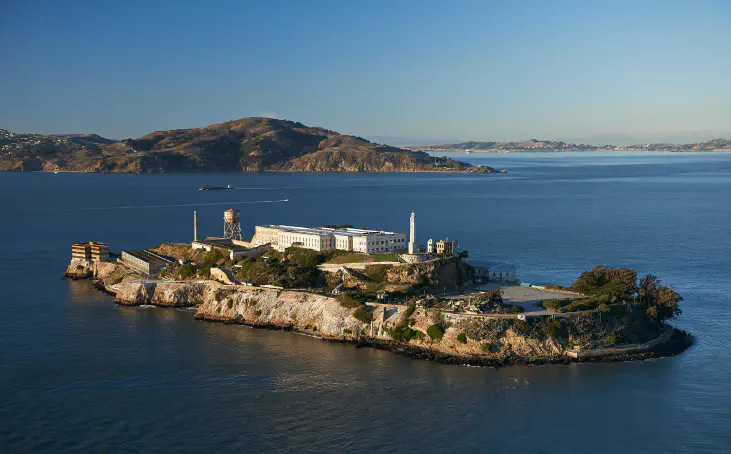Alcatraz, also known as “The Rock,” was a maximum-security federal prison located on an island in the San Francisco Bay, California, USA. The prison operated from 1934 to 1963 and housed some of the country’s most dangerous and notorious criminals, including Al Capone and George “Machine Gun” Kelly.
The prison was built to be virtually escape-proof, as it was located on an island with strong currents and frigid waters that made it nearly impossible to swim to the mainland. The prison also had a variety of security measures, including armed guards, guard towers, and metal detectors.

— Cameron Davidson
The cells at Alcatraz were small and spartan, with no amenities beyond a cot, a sink, and a toilet. Inmates were allowed few personal belongings and were closely monitored at all times. Despite these harsh conditions, some inmates managed to find ways to communicate with each other and plan escape attempts, including the infamous 1962 escape of Frank Morris and the Anglin brothers.
The Planning and Execution of the Escape
Frank Morris was born in Washington D.C. in 1926 and was a career criminal. He was first arrested at the age of 13 and spent much of his adult life in and out of prison for various crimes. John Anglin was born in Georgia in 1930 and was also a career criminal. He had a history of bank robbery and had escaped from prison twice before his incarceration at Alcatraz. Clarence Anglin was John’s younger brother, born in Georgia in 1931. He had also been involved in various criminal activities, including bank robbery.

— Public Domains
The three men met while serving time at the Atlanta Penitentiary and were transferred to Alcatraz in 1960. While at Alcatraz, they began planning their escape, which involved digging through the walls of their cells and creating fake heads to place in their beds to fool the guards.
On June 11, 1962, three inmates at Alcatraz Federal Penitentiary, Frank Morris, John Anglin, and his brother Clarence Anglin, successfully escaped from their cells and made their way off the island.
They had been working for months to dig through the walls of their cells using spoons and other tools they had fashioned. They also created fake heads out of paper mach to place in their beds to fool the guards during their escape.

— Public Domains
Once they made it out of their cells, they climbed up to the roof of the prison and used a makeshift raft to escape the island. They were never seen again and it is presumed they drowned in the San Francisco Bay, but their bodies were never found.
The Aftermath of the Escape
After the discovery of the empty cells and the fake heads, prison officials immediately launched a search for the escaped inmates. A massive manhunt was initiated, involving the FBI, the U.S. Marshals Service, and the Coast Guard.
Search parties scoured the surrounding waters, and nearby cities were put on high alert. The search was extensive, with authorities investigating numerous leads and tips from the public.
Despite the efforts of law enforcement, no trace of the escaped inmates was ever found. In the weeks and months following the escape, a number of items believed to belong to the inmates were discovered, including a makeshift raft made from raincoats and paddles.
However, there was no sign of the three men themselves, and they were never seen again. The official investigation into the escape was eventually closed, and the FBI concluded that the inmates likely drowned in the cold waters of the San Francisco Bay.
However, some people continue to believe that the inmates may have survived and managed to evade capture. Over the years, various pieces of evidence have emerged that have fueled speculation about the possibility of the escapees’ survival, including eyewitness accounts and alleged sightings of the escaped inmates. Despite these claims, however, no concrete evidence has ever been found to support the idea that the three men successfully escaped and started new lives.
Two days after the escape, a small raft made of raincoats was discovered floating in the San Francisco Bay near Angel Island. The raft was partially deflated and waterlogged, and it was later determined to have been constructed using 50 raincoats that had gone missing from the prison’s inventory.
Investigators also discovered two paddles that were believed to have been used by the escapees to navigate the raft. The discovery of the raft and paddles suggested that the inmates had likely attempted to make their way to the mainland by crossing the treacherous waters of the San Francisco Bay.
In addition to the raft and paddles, a number of other items were found in the weeks and months following the escape that were believed to have been used by the inmates, including clothing and personal items. However, there was no definitive evidence that the escaped inmates had survived, and many experts believe that they likely perished in the cold, rough waters of the Bay.
The Closure of Alcatraz Prison
Alcatraz Federal Penitentiary was closed on March 21, 1963, due to high operating costs and the deteriorating condition of the prison.
The cost of maintaining the aging facility on an isolated island in the San Francisco Bay was extremely high, and the prison had become increasingly unpopular with both the public and government officials. Additionally, improvements in prison security and advancements in technology made Alcatraz less necessary as a high-security prison.
After the closure of the prison, the island was briefly occupied by Native American activists in 1969, who demanded that the land be returned to indigenous people. The occupation lasted for 19 months and brought attention to issues of indigenous rights and activism.
Today, Alcatraz is operated by the National Park Service as part of the Golden Gate National Recreation Area and is a popular tourist attraction, drawing over a million visitors each year. Visitors can take a ferry to the island and tour the prison and learn about its history as a high-security federal penitentiary.
Learning More The Escape
The escape from Alcatraz has captured the public’s imagination for decades and has been the subject of books, movies, and TV shows. Many theories have been put forth about what really happened to the escapees, including the possibility that they survived and made it to freedom.
There have been several articles, books, and documentaries that detail the escape and its aftermath. If you’re interested in learning more, here are some specific resources for you to check out.
“Escape from Alcatraz” (1979) - a movie starring Clint Eastwood that dramatizes the escape.
“Escape from Alcatraz: The Mystery of the Three Men Who Escaped From The Rock” by Eric Braun (2017) - a nonfiction book that provides a detailed account of the escape and explores some of the theories about what happened to the escapees.
“Alcatraz Escape: The Lost Evidence” (2017) - a History Channel documentary that investigates new evidence that suggests the escapees may have survived and made it to South America.
“Escape from Alcatraz” (2001) - an episode of the TV show “Secrets of the Dead” that explores the various theories about what happened to the escapees.
“Escape from Alcatraz: The Untold Story” (2018) - a documentary that features interviews with family members of the escapees and explores their possible motivations for attempting the escape.
I hope these resources are helpful to you!
Sources
- History Channel: Escape from Alcatraz
- FBI Records: Alcatraz Escape
- National Park Service: Alcatraz Island: The Escape
- Smithsonian Magazine: Alcatraz’s Captivating Hold on History



